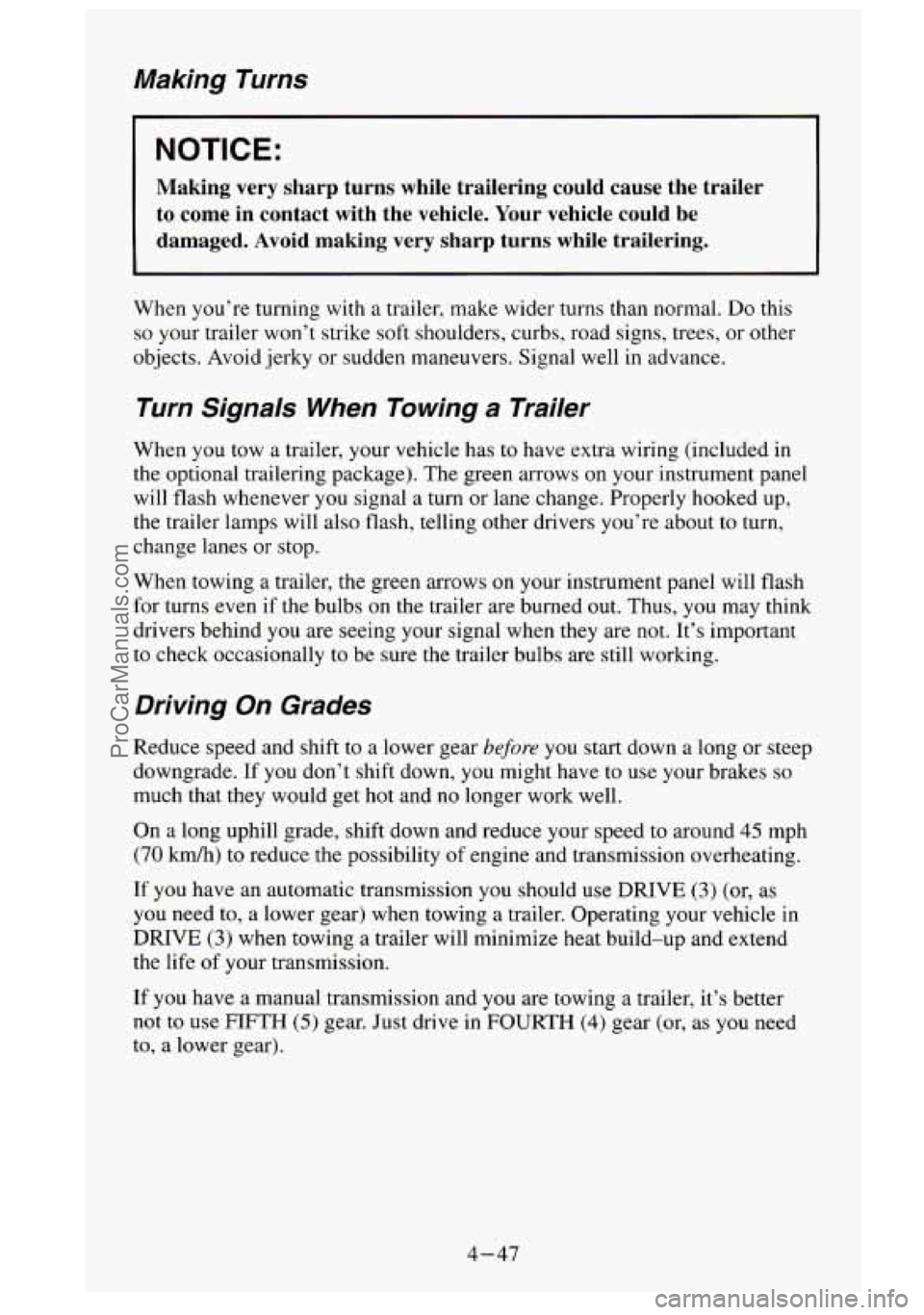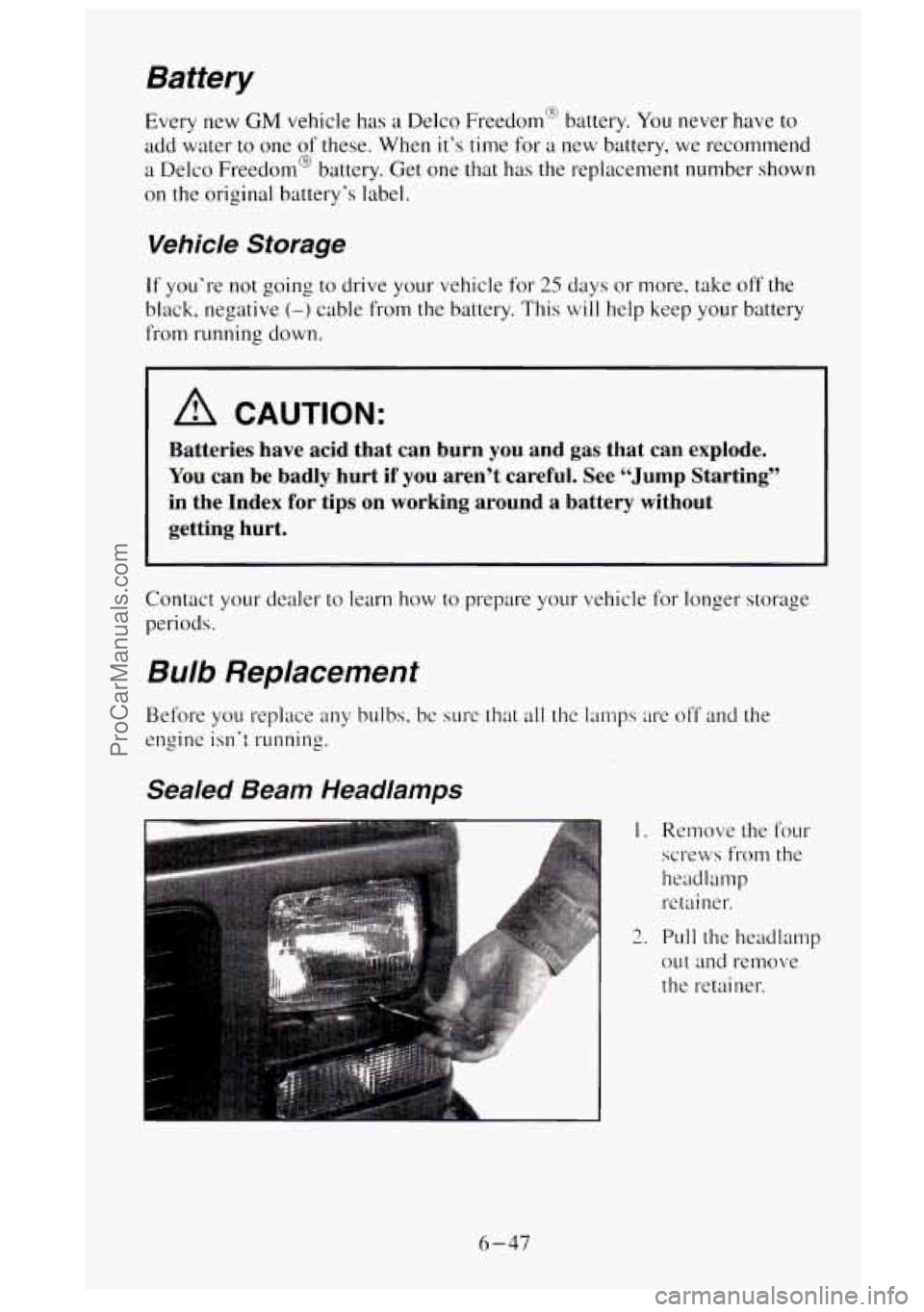Page 102 of 488
To signal a turn, move the lever all the way up or down. When the turn is
finished, the lever will return auto~natically.
A green arrow on the
instrument panel will
flash in the direction
of the turn or lane
change.
To signal a lane change, just raise or lower the lever until the green arrow
starts to flash. Hold
it there until you complete your lane change. The lever
will return by itself when you release it.
As you signal a turn or a lane change, if the arrows flash at twice the normal
rate,
a signal bulb may be burned out and other drivers may not see your
turn signal.
If a bulb is burned out, replace it to help avoid an accident. If the green
arrows don’t go on at all when
you signal a turn, check for burned-out bulbs
and
a blown fuse (see “Fuses” in the Index).
Headlamp High-Low Beam
To change the
headlamps from low
beam to high or high
to low, pull the
multifunction lever all
the way toward
you.
Then release it.
2-40
ProCarManuals.com
Page 221 of 488

Making Turns
I NOTICE:
Making very sharp turns while trailering could cause the traile\
r to come in contact with the vehicle. Your vehicle could be
damaged. Avoid making very sharp turns while trailering.
When you’re turning with a trailer, make wider turns than normal. Do this
so your trailer won’t strike soft shoulders, curbs, road signs, trees, or other
objects. Avoid jerky or sudden maneuvers. Signal well in advance.
Turn Signals When Towing a Trailer
When you tow a trailer, your vehicle has to have extra wiring (included in
the optional trailering package). The green arrows
on your instrument panel
will flash whenever
you signal a turn or lane change. Properly hooked up,
the trailer lamps will also flash, telling other drivers you’re about to turn,
change lanes or stop.
When towing a trailer, the green arrows on your instrument panel will flash
for
turns even if the bulbs on the trailer are burned out. Thus, you may think
drivers behind
you are seeing your signal when they are not. It’s important
to check occasionally to be sure the trailer bulbs are still working.
Driving On Grades
Reduce speed and shift to a lower gear before you start down a long or steep
downgrade. If
you don’t shift down, you might have to use your brakes so
much that they would get hot and no longer work well.
On
a long uphill grade, shift down and reduce your speed to around 45 mph
(70 kmh) to reduce the possibility of engine and transmission overheating.
If you have an automatic transmission
you should use DRIVE (3) (or, as
you need to, a lower gear) when towing a trailer. Operating your vehicle in
DRIVE (3) when towing a trailer will minimize heat build-up and extend
the life
of your transmission.
If you have a manual transmission and
you are towing a trailer, it’s better
not to use FIFTH (5) gear. Just drive in FOURTH (4) gear (or, as you need
to, a lower gear).
4-47
ProCarManuals.com
Page 313 of 488

Battery
Every new GM vehicle has a Delco Freedom@ battery. You never have to
add water to one of these. When it’s time for a new battery, we recommend
a Delco Freedom@ battery. Get one that has the replacement number shown
on the original battery’s label.
Vehicle Storage
If you’re not going to drive your vehicle for 25 days or more. take off the
black, negative (-) cable from the battery. This will help keep your battery
from running down.
A CAUTION:
Batteries have acid that can burn you and gas that can explod\
e.
You can be badly hurt if you aren’t careful. See “Jump Start\
ing’’
in the Index for tips on working around a battery without
getting hurt.
Contact your dealer to learn how to prepare your vehicle for longer storage
periods.
Bulb Replacement
Before you replace any bulbs. be sure that all the lamps are off and the
engine isn’t running.
Sealed Beam Headlamps
I. Remove the four
screws from the
headlamp retainer.
2. Pull the headlamp
out and remove
the retainer.
6-47
ProCarManuals.com
Page 314 of 488
Halogen Bulbs
3. Unplug and remove
the
headlamp.
headlamp and put
it in place.
4. Plug in the new
5. Install the
retainer
to the
headlamp and
tighten the
screws.
A CAUTION:
Halogen bulbs have pressurized gas inside and can burst if you
drop or scratch the bulb. You or others could be injured. Take
special care when handling and disposing
of halogen bulbs.
NOTICE:
Avoid touching the bulb or letting it come in contact with
anything damp.
Oil from your skin or moisture on the bulb can
cause the bulb to explode when it
is turned on. If either comes in
contact with the bulb, clean it with alcohol or
a suitable
degreaser and wipe the bulb dry.
6-48
ProCarManuals.com
Page 315 of 488
Composite Headlamps
1. Remove the two screws
at the top
of the radiator
support.
2. Pull the headlamp
lens assembly
out.
1
3. Unplug the
electrical
connector.
4. TLH-II the bulb to
the left and
remove
it.
5. Put the new bulb in the lens assembly and turn it to the right until it is
tight.
6. Plug in the electrical connector.
7. Put the headlamp lens assembly back into the vehicle. Install and
tighten the two screws.
6-49
ProCarManuals.com
Page 316 of 488
Front Parkingnurn Signal Lamps with Sealed Beam
Headiamps
1. Remove the two
screws at the
inside edge
of the
parkinghrn
signal lamp
assembly.
2. Remove the lamp assembly by swinging it out from the inside edge and
sliding
it out at the outside edge.
3. Squeeze the tab
on the side
of the
lamp socket
while turning the
socket
to the left.
4. Pull the socket
out
of the lamp
assembly.
5. Push in gently on the bulb, turn it to the left and remove it from the
socket.
6. Put the new bulb in the socket, gently press in on the bulb and turn it to
the right until it is tight.
7. Put the socket back into the lamp assembly and turn it to the right until
it locks.
8. Put the parking/turn signal lamp assembly back inlo the vehicle and
tighten the screws.
4-50
ProCarManuals.com
Page 317 of 488
Front Parkingflurn Signal Lamps with Composite
Headlamps
1. Remove the
screws and take
out the
parkinghum
signal lamp
assembly.
2. Squeeze the tab
on the side of the
lamp socket
while turning the
socket to the left.
3. Pull the socket
out: of the lamp
assembly.
4. Push in gently on
the bulb, turn
it to
the left and
remove
it from
the socket.
5. Put the new bulb in the socket, gently press in on the bulb and turn it to
the right until it is tight.
6. Put the socket back into the lamp assembly and turn it socket to the
right
until it locks.
7. Put the parkinghurn signal lamp assembly back into the vehicle and
tighten the screws.
6-51
ProCarManuals.com
Page 318 of 488
Side Marker Lamps with Sealed Beam and Composite Headlamps
1. Remove the
screws and pull
out the
parkinghum signal lamp
assembly.
2. Reach through
the opening and
turn the side
marker bulb
socket to the left
and remove
it.
3. Pull the bulb
straight out
of the
socket.
4. Put a new bulb
into the socket
and push it in
until it is tight.
5. Put the socket back into the side marker assembly and turn it to the
right to tighten it.
6. Replace the parking/turn signal lamp assembly and tighten the screws.
6-52
ProCarManuals.com